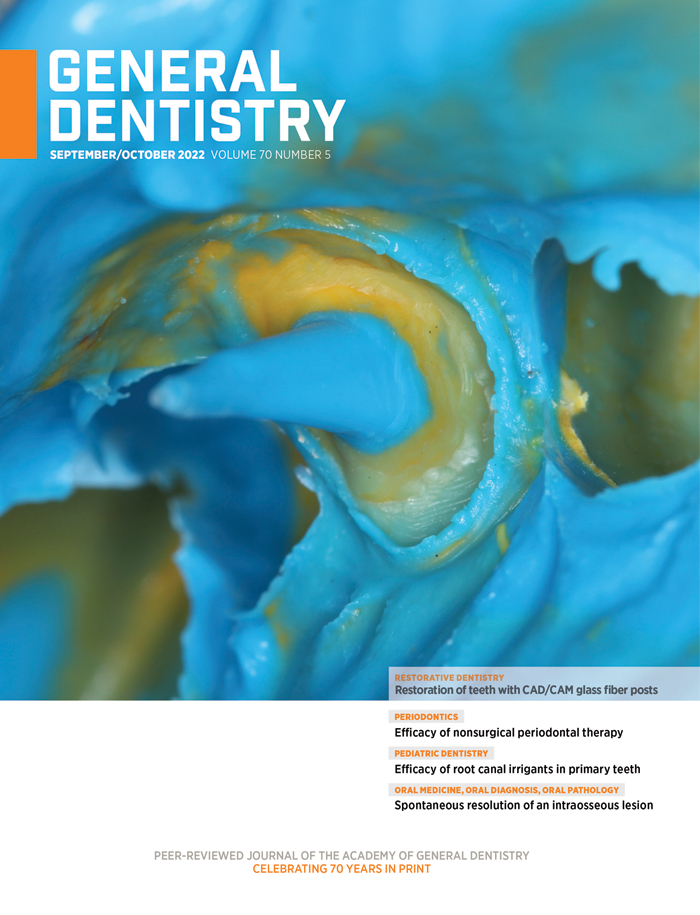-
SELF-INSTRUCTION
Periodontics
Efficacy of nonsurgical periodontal therapy for treatment of periodontitis: practical application of current knowledge
Sultan Albeshri
Gary Greenstein
A review of the literature published within the last 5 years revealed that some adjunctive treatments, including local antibiotic or antiseptic delivery, photodynamic therapy, and probiotic therapy, yield modest improvements compared with scaling and root planing alone. The use of systemic antibiotics should be reserved for patients who do not respond to conventional therapy. Recent clinical trials have failed to show that lasers provide a significant clinical benefit compared with nonsurgical therapy.
2022 September/October; 70(5):12-19.
Full Article (PDF)
Self-Instruction Exercise No. GD498
-
SELF-INSTRUCTION
Basic Science
Fracture load of zirconia crowns based on preparation and cement type
John S. Jenista
Wyeth L. Hoopes
James F. Knowles
Kraig S. Vandewalle
This study evaluated the effect of axial wall height (AWH) and type of bonding cement on the fracture load of zirconia crowns. Both AWH and cement showed significant effects. Significantly greater fracture loads and catastrophic root fractures were demonstrated by crowns with an AWH of 2 mm or greater, regardless of cement type. Adhesive resin cement may provide greater fracture resistance when preparations have minimal (0-mm) AWH.
2022 September/October; 70(5):22-27.
Full Article (PDF)
Self-Instruction Exercise No. GD499
-
SELF-INSTRUCTION
Pediatric Dentistry
Cleaning efficacy of various root canal irrigants in primary teeth: a scanning electron microscopic study
Leila Basir
Rahim Abdi
Elahe Hashemi
This study evaluated the efficacy of 4 different solvents for irrigating root canals in primary teeth. Compared with 17% ethylenediaminetetraacetic acid, 2% iodine–potassium iodide, and 1% sodium hypochlorite, a solution of 3% sodium hypochlorite showed the greatest efficacy for cleaning the root canal in primary anterior teeth.
2022 September/October; 70(5):29-33.
Full Article (PDF)
Self-Instruction Exercise No. GD500
-
Esthetics/Cosmetic Dentistry
Efficacy and durability of bleaching with diode lasers: an in vitro study
Marzieh Rohaninasab
Nastaran Alinejad
Nazanin Kiomarsi
Sedighe Sadat Hashemikamangar
An in vitro study assessed the efficacy and durability of bleaching with 940- and 980-nm diode lasers over a 9-month period. The 940-nm diode laser, 980-nm diode laser, and conventional hydrogen peroxide gel all provided equally effective bleaching, and the color change remained clinically perceptible throughout the study period.
2022 September/October; 70(5):35-39.
Full Article (PDF)
-
Oral Medicine, Oral Diagnosis, Oral Pathology
Spontaneous resolution of an intraosseous mandibular lesion: a case report and review of the literature
Katrina L. Kontaxis
Raphaël Chalich
Ilyas Dakak
Adel Kauzman
A case report and review of the literature illustrate how certain mandibular bony lesions have the potential to spontaneously regress, obviating the need for invasive surgery. A clear and thorough differential diagnosis is essential, as is the need to rule out the possibility of aggressive lesions.
2022 September/October; 70(5):40-48.
Full Article (PDF)
-
Restorative Dentistry
Do composite resin polishing systems damage enamel?
Britta S. Ristau
Bruce N. Hamilton
Anne E. Hill
Daranee Tantbirojn
Antheunis Versluis
An in vitro study comparing enamel loss surrounding composite resin restorations after different finishing and polishing sequences found that the majority of enamel damage resulted from the finishing burs. Little enamel was removed by either of the tested composite resin polishing systems.
2022 September/October; 70(5):49-53.
Full Article (PDF)
-
Implants
Frictional wear of stud implant overdenture abutments after 2 years of in vitro simulated function
Jorge Mosquera Castrillon
Jack Piermatti
Ria Achong-Bowe
Patrick Hardigan
Jeffrey Thompson
A study investigating frictional wear in a commonly used type of abutment after 2 years of simulated overdenture insertions and removals showed that wear on the titanium nitride abutment coating resulted in a decrease of up to 50% in removal forces of the male nylon inserts. The combination of wear of the titanium nitride coating and decrease in retention load values suggests that stud abutments should be replaced after 2 years of use.
2022 September/October; 70(5):54-57.
Full Article (PDF)
-
Implants
Revisiting rigid overdenture design following traditional removable prosthetic concepts: a case report
Mary Kang
Christine W. Chu
Richard D. Trushkowsky
Babak Hamidi
Gary R. Goldstein
This case report describes a modern design for implant overdentures that conforms to fundamental removable prosthetic principles by using a rigid bar with bilateral locking attachments. This design is a suitable treatment option for patients who desire the sensation of a fixed prosthesis but are unable to receive a fully implant-supported prosthesis.
2022 September/October; 70(5):58-61.
Full Article (PDF)
-
Pediatric Dentistry
Revisiting the use of stainless steel crowns for treatment of molar-incisor hypomineralization: a case series
Isabella Claro Grizzo
Aliny Bisaia
Camilla Cristina Lira di Leone
Fabiana Giuseppina Di Campli Regnault
Fernanda Lyrio Mendonça
Daniela Rios
This case series reports the use of stainless steel crowns without tooth preparation in 3 patients with molar-incisor hypomineralization. Although this conservative treatment is a temporary solution, it provides good longevity and preserves tooth structure until the patient reaches maturity for a definitive restoration.
2022 September/October; 70(5):62-66.
-
Restorative Dentistry
Effect of preheated composite resin luting agents on the color of ceramic laminates
Luiza Isola Caminha
Monique Dors
Cristina Pereira Isolan
Fabíola Jardim Barbon
Noéli Boscato
This in vitro study evaluated the effects of preheating, ultrasound, and composite resin composition on optical and rheological characteristics of feldspar ceramic laminates. Overall, the use of preheated composite resins as luting agents offers similar to poorer performance than conventional resin cement.
2022 September/October; 70(5):67-73.
Full Article (PDF)
-
Restorative Dentistry
Restoration of teeth with customized CAD/CAM glass fiber posts: report of 2 cases
Ana Carolina Andreucci
Antônio Carlos Tavares
Fabiana Tavares Lunardi Palhari
Priscila Christiane Suzy Liporoni
Maiara Rodrigues de Freitas
Flávio Henrique Baggio Aguiar
Rayssa Ferreira Zanatta
Two case reports are presented to illustrate computer-aided design/computer-aided manufacturing of glass fiber posts to restore teeth with severe coronal destruction. The post and core are milled in a single unit, decreasing the risk of failure, and the customized post provides better adaptation and requires a thinner layer of cement.
2022 September/October; 70(5):74-77.
Full Article (PDF)

